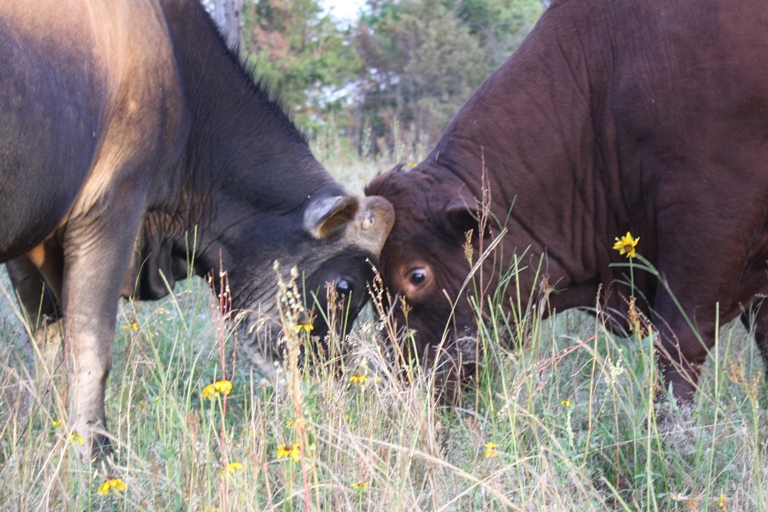
The above picture shows our two bulls, Pedro and Big John. Pedro is a dairy Jersey bull descendant from a beautiful, productive milk cow raised in East Texas, and Big John is a beef Red Devon bull descendant from one of the most famous Devon herds in the world. They are enjoying a friendly head-butt in the pasture. Picture taken by Rebekah Fisher.
True Husbandry
Being a rancher means so much more than simply making sure the animals have food and water. A good husband (to animals, as in “husbandry”) learns what to look for in the offspring produced by his herd in order to make plans for the future. A rancher must decide whom to keep and whom to eat in such a way that allows him to be profitable long-term. For example, selling the fattest animal might make a quick buck now, but it could have been your best potential breeder that may have produced many more excellent quality animals. It is almost a form of tithe or sacrifice in which you “save the best and eat the rest.” It is somewhat ironic that the best beef animal is the one who never sees the dinner plate, but it is very much like crop-growers who let the earliest, juiciest, prettiest, best fruits go to seed so that they preserve those excellent characteristics for future generations.
Herd Qualities at Shady Grove Ranch
At Shady Grove Ranch, we have specific guidelines for animals to be selected as breeding stock in our beef and dairy herds. Since most operations keep only one or two bulls to breed all their females, it is crucial that the genetics the herd sire passes on are top-quality. Many ranchers, including us, believe that the herd sire can make or break their operation, so we are very careful to select one or two bullocks from the calves born each year that might make a great herd sire some day. But each herd has a different purpose. For example, TrueFields LLC (a separate company owned by Matt and Jerica and one other partner) manages a cowshare milking herd, and so they look for good milking qualities. Shady Grove Ranch keeps the grass-fed beef herd, so we watch for good meat-producing qualities in our beef bulls.
It is interesting to learn how different farmers raise and select their animals. The main things we look for when selecting breeding stock are: 1. ability to breed back every year; 2. general robustness; 3. docility/mothering ability; 4. body conformation; and 5. coat health. These characteristics give us clues about how an animal will perform in our climate and under our management techniques. Not all animals will thrive in a pasture-based operation in East Texas. They must be able to handle the heat and they must be able to grow well on the available forage. The practical manifestations of those characteristics are seen in an animal’s ability to shed its coat in spring and to maintain a compact body shape that will fatten efficiently without grains.
Many cattle breeds originated in climates much cooler and more lush than here, so selecting animals with genetic predispositions to do well here is crucial to our success. Zooming in on beef genetics versus dairy genetics, our end product is somewhat different for those two types of animal, so we watch for different expressions of traits that indicate the animals will perform well at their given tasks. We look for the same general characteristics, but dairy animals look and act differently than beef animals, so we must take that into consideration when making culling decisions.
Meet The Bulls
At the beginning of this article, you met our two herd bulls, Big John and Pedro. Big John, our red Devon beef bull, is about twice the age of Pedro, TrueFields’ Jersey dairy bull. Big John is also likely twice Pedro’s weight. Being a beef bull, Big John is a product of careful breeding selection to quickly produce a short, fat, meaty animal on forage alone. Since he is raised organically, his offspring must demonstrate the ability to resist disease with the given tools (minerals and good nutrition) and without medications and chemicals. Survival of the fittest is true on a cattle ranch!
Big John – Red Devon Grass-fed Beef Bull
When we purchased Big John at a discount due to a partially undescended testicle in 2010, he was a bit on the scraggly side, and much thinner than he is today. Now that he is full-grown and managed with much attention paid to frequent pasture rotation and mineral intake, his muscle mass has greatly increased and he has successfully bred our dairy and beef herds each year since we got him, despite his “disability.”
Despite having only one normal testicle, which we speculate happened because of a mineral deficiency during his maturing years, Big John is now very healthy and very fertile. We know this not only because of his performance, but also because of his appearance. You can learn a lot about the biological health of an animal by looking at its coat. Devon bulls should have short, coarse, wavy hair on their heads and necks. They should shed their winter coats on time and not be shaggy going into the summer season. Just 6 months after we added individualized minerals, Big John shed all his winter fuzz promptly and put on so much weight that he showed “happy lines” on his ribs in May 2012. In the following picture, you can see some faint horizontal lines near the end of Big John’s midsection. These are happy lines, and their presence is an indicator of good endocrine function and balanced nutrition. Happy lines make us happy!
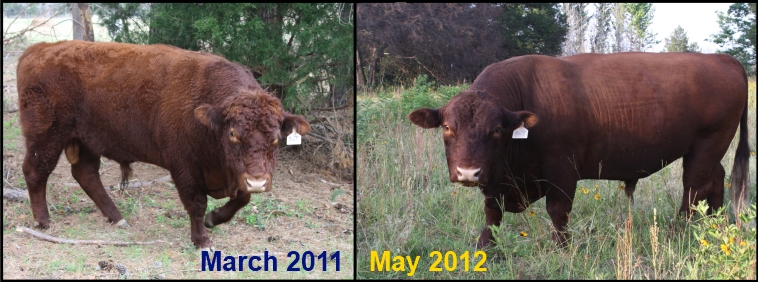
This picture illustrates the difference only a year can make when you use careful management techniques. If you remember reading about our Bovine Buffet, we added “cafeteria-style” minerals in December 2011, which we believe aided the cattle’s performance. Though Big John had fair body conformation in March 2011, he still had a heavy winter coat (which is bad in East Texas at that time of year). Now his coat is sleek and smooth, complete with "happy lines" on his ribs! Pictures taken by Rebekah Fisher.
Matt is very proud of Big John’s performance, though we have only met about six or seven of his calves: many of them are still in Kentucky waiting for their ticket home after their winter away from drought country! Big John has a thick, long body and dark wavy hair on his neck and head and well-proportioned (i.e., short) legs. He is a great beef bull.
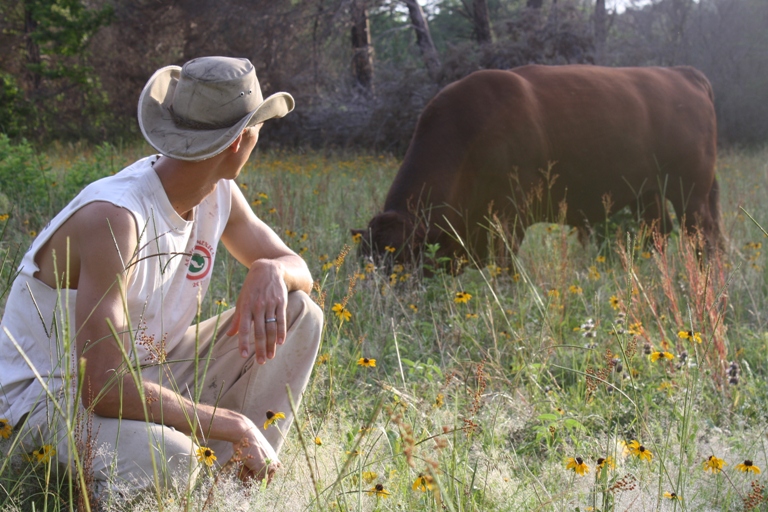
Big John is gentle and easy-going, which is important on a small, intensively managed ranch like ours. Though we are careful to always keep an eye on him when we are out in the pasture, he and the rest of the herd are docile enough to allow us to do our work and handle our animals without hot-rods, nose-rings, or prods. Matt can usually separate Big John from the herd with a few waves of his hat and claps of his hands. Picture taken by Rebekah Fisher.
Breeding Herd Selection
Investing money, time, and energy into a bull is a pretty big deal, because it takes almost three years from the time you start to use the bull to know whether he is performing well. When he breeds a heifer (a maiden cow), it takes almost ten months for the calf to be born. Then it takes about two years for that calf to grow up to a production age. At that time, if the animal has the right body conformation and is healthy and robust, it is evaluated for keeping as breeding stock. If not, it gets culled, which means it is finished out on forage and put into the freezer.
We haven’t had very many animals that displayed outright poor health, and all of them eventually fatten on pasture. But it can take many years to develop the ideal herd for particular pastures. At Shady Grove Ranch we are only two years in! Even if the offspring were all amazing quality, we can’t keep all of them at our relatively small 100-acre ranch in Jefferson, Texas. We need only one or two beef bulls, so the males really have to prove themselves to be selected as a future herd sire.
If the calf is female, she is more likely to be kept, but only if she shows the same robustness, docility, and pasture-performance as her parents. We have to cull the females, too. Among a group of full-grown females we look first for reproductive performance: did she have a calf on time this year? In fact, we often remove the bull from the herd before summer in order to prevent late breeding. We then do a pregnancy check in the fall. If any of the females are not bred, we cull them before winter to make efficient use of our resources. Even if they did have calves during the previous spring, at weaning time we look for sleek coats, calf quality, docility, and resistance to disease. However, we cannot count body condition too much against mothers which have just raised a calf, because lactation is hard work and often makes a good mother ribby by the end of the season. Still, if she does not seem to be performing well, we wean her calf, fatten her out and she also is culled.
Pedro—Pasture-Based Dairy Bull
Pedro is a pure-bred Jersey bull raised in East Texas. There is only one other Jersey cow in the TrueFields LLC dairy herd, but all milk cows need to be bred each year in order to produce milk. We chose a dairy breed (Jersey) so that we can use the female offspring as milk cows when they grow up. The same basic criteria applies to dairy animals in a pasture-based operation: sleek coat, reproductive ability, resistance to disease, and body conformation (which is the most obvious manifestation of foraging efficiency). Milk cows, however, have very different body types than beef animals. They tend to be more angular, have bigger udders, and have larger midsections. Side by side, a healthy beef animal and a healthy milk animal may look very different. Any time we are evaluating breeding stock (beef or dairy), we take into account the appearance of their reproductive organs, but this is especially true of dairy animals, since their purpose is directly related to reproduction (i.e., lactation).

Many grass-fed animals are slim through their growing years while their bodies focus their energy on making a structural frame. Pedro is still not quite full grown, but you can see a big difference in his body condition after only 5 months of being at Shady Grove Ranch.
Dairy Herd Selection
Just as in humans, male cows (bulls) have mammary organs—we call them teats in cattle—and in both male and female breeding stock, these need to be uniform and have good placement. The reason for this is that it is imperative that a dairy cow is able to be milked on all four teats. Calves don’t mind a couple of funny-looking teats, though we prefer udder uniformity even in our beef cows. But a cow which will be milked by hand or machine needs to have an udder that is easy to clean and work with.
We chose Pedro partly because of the conformation of his mother’s udder. The udder is the second-most important organ in a milk cow (second only to the rumen, the cow’s digestion tank). It must be uniform with four operational teats. It cannot be pendulous, meaning it hangs low and does not have strong ligaments and is at risk of being stepped on by the cow or her herdmates. We also look for moderately-sized udders. A bag that is too big may become very inflamed after calving, causing mastitis and pain for the cow.
We also chose Pedro because he is very docile. Dairy bulls can turn dangerous when they get older because they are often bottle-fed by humans and do not distinguish the difference in species. We are very careful with Pedro to ensure that we don’t get buddy-buddy with him. He is a cow and we are the dominant humans. Even in our young bottle-fed dairy heifers, we are careful that they do not “play” with us so that they maintain that instinctual respect for us. Genetically speaking, in both male and female offspring, we look for mellow, easy-going animals. Not only are high-strung animals dangerous, they do not perform well under the constant human interaction involved with milking, and we need the cows to get along well, too, so that infection-causing injuries are prevented.
Finally, we chose Pedro because he has a compact frame. We hope to size down the future TrueFields milk cows so that they perform more like the beef cows on forage alone. It is hard work for an animal to produce enough milk for a calf and people. It is difficult to get all the calories she needs from forage alone, especially if she has a large frame. For this reason, we supplement certified organic corn and oats, but long-term, as our pasture fertility improves and our herd genetics are refined, we hope to eliminate purchased feed altogether in the dairy herd.
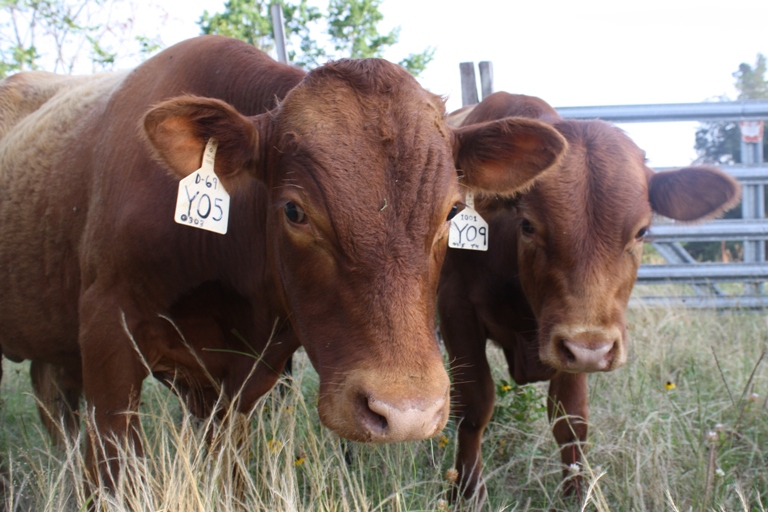
Here are two of our young up-and-coming potential bulls. They were born in 2011, indicated by the “Y” in their tag numbers, and will be “interviewed” for herd sire-ship sometime next year. Their birth dates, mother’s tag numbers, and birth order are also indicated on the tag. This information assists us when culling time comes, both for offspring and mothers. The tags are in their right ears so that from far away we can tell that they are bulls and not heifers, which are tagged in their left ears. Picture taken by Rebekah Fisher.
Sometimes You Have to Say Goodbye
It’s not always easy saying goodbye to calves you raised from birth, but we know that these animals have a dignified purpose—nourishing people. We take good care of these cows so they will take good care of us. It’s almost breeding season again, so we are looking forward to meeting Big John’s and Pedro’s offspring next year!
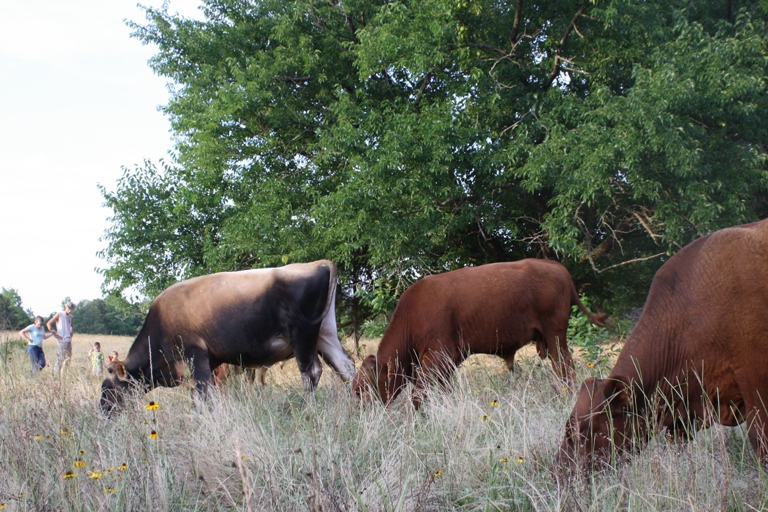
The bulls graze along our pastures in herd formation with Pedro in the lead. Picture taken by Rebekah Fisher.


